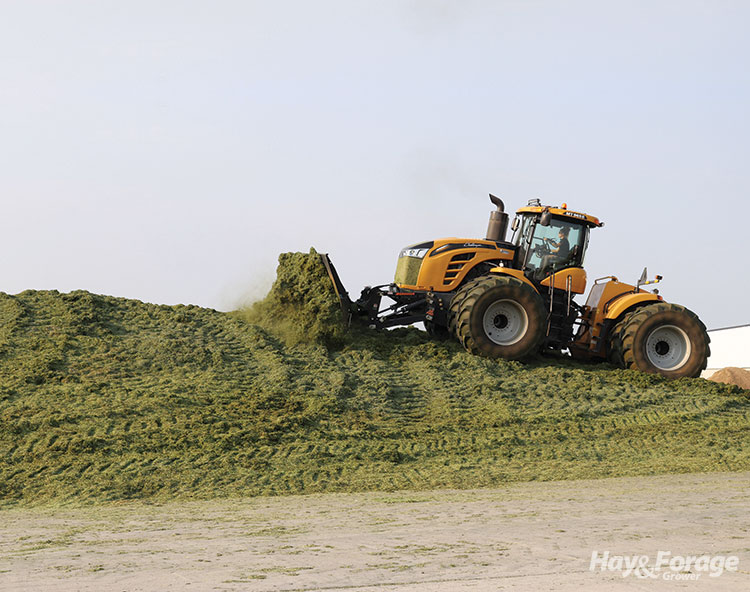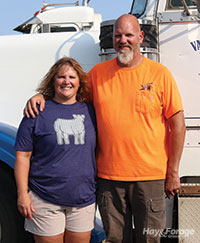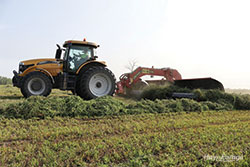The author is a freelance writer who lives in Brookings, S.D. Raised on a cattle ranch near Spearfish, S.D., she earned an agricultural communications degree from South Dakota State University.

Some of Jason Van Kooten’s earliest memories are of sitting on the back window ledge of a Farmall 1466 tractor, pulling a chopper while alfalfa was being chopped for his grandfather’s dairy cows. Forage harvesting is deeply engrained in generations of Van Kooten’s family, and today he owns a custom forage harvesting business in Volga, S.D.
Van Kooten Ag Service stays busy with custom alfalfa and corn silage harvesting, hauling, and packing. The business also provides hay grinding services and does cornstalk chopping and baling.
Van Kooten is a fifth-generation dairy farmer originally from central Iowa. He spent the early part of his career working on the family dairy farm with his dad and brother before moving to Volga in 2003.
There, Van Kooten started helping a friend with forage harvesting. The following year, he bought a chopper from his dad and began custom chopping for producers in the area.
This year, Van Kooten’s crew chopped around 20,000 acres of alfalfa and 12,000 acres of silage for dairy and beef producers within about a 50-mile radius of Volga. “I have done forage harvesting my entire life, and in a way, I don’t know any better,” Van Kooten said. “I love doing this, and it truly doesn’t feel like I’m working.”
A good crew

Additionally, he has six full-time employees and a lot of seasonal help. He hires several men from South Africa to work for him six to eight months of the year through the government’s H-2A program. This year, he has 10 employees from South Africa, including several who have worked for him in previous years as well. “It’s really important to me to have the same crew each year, if possible, because we really want them to be a part of our family and our team,” he said.
During silage chopping season, Van Kooten’s team expands to include 56 truck drivers, 10 chopper operators, and 10 push tractor operators. They run 24 hours a day during corn harvest, with shifts of 12 hours on and 12 hours off. Much of their help during corn harvest comes from friends and family.
Having a close relationship with his employees is a priority for Van Kooten. “A lot of people say not to get too close to your employees, but I am guilty of doing that,” he said. “It’s really important to me to have a personal relationship with them, and we often spend time outside of work together.”
He emphasized that all the pieces of the puzzle are equally important when it comes to chopping. “I try to get my whole crew on the same page that each job is just as important as the next, whether that’s running a chopper or a tractor,” Van Kooten said. “Chopping is a lot like running a relay — everyone has to work together to be successful.”
Full-service harvesting
Van Kooten Ag Service offers full-service forage harvesting, so they cut, merge, chop, haul, and pack alfalfa. Van Kooten works with the producers to evaluate when their alfalfa is ready to harvest. He relies partly on the moisture meter in the Claas harvesters he runs, and heavily on his own intuition by handling the alfalfa and breaking stems.

A 24-hour wait period between cutting and chopping is typical. However, this year Van Kooten experienced a memorable first because of the dry conditions – they cut an alfalfa field at 10 a.m. and chopped it at 4 p.m. Four cuttings are typical for his customers, but this year it really varied due to dry weather and a significant variation in rainfall.
If the alfalfa gets too dry when they are chopping, Van Kooten will apply water using a tank that is pulled behind the chopper. Typically, this isn’t a problem, but due to hot and dry conditions this summer it was a more common harvest strategy. Once the alfalfa is chopped, he does a squeeze test on it to gauge the moisture.
Van Kooten harvests corn silage at a 65% to 68% moisture content. He uses the moisture meter in his Claas harvesters to confirm moisture levels. He sometimes also uses a Koster tester or microwave to monitor silage moisture content.
To pack the chopped alfalfa and silage, Van Kooten buys the heaviest tractors he can find and then adds more weight to them. He runs two tractors per chopper and has them drive as slow as possible on the piles. “It is extremely important for the tractors to stay on the pile the entire time while packing and to pack from all directions to minimize spoilage,” he said.
Van Kooten Ag Service also grinds hay for about 20 dairies and 50 beef producers year-round, using two Haybuster grinders. During the winter, they are grinding hay every day.
“One of the biggest challenges I face is dealing with trucks breaking down,” Van Kooten said. “Our trucks have a rough life, and we are really hard on them. I’m thankful for a great crew that gets our trucks back up and running.”
Efficiency rules
Over the last couple years, Van Kooten has learned that profitability is highly linked to efficiency. The primary way he maximizes efficiency is by having the equipment ready to go before arriving at the field. Additionally, he strives to get all his work lined up in one area so that minimal time is spent moving equipment up and down the road.
Van Kooten is also trying to maximize the efficiency of his choppers by being able to complete an entire 12-hour shift without stopping to refuel. This was accomplished by adding fuel containment capacity to the machines.
“At the end of the day, though, I really do believe that the most important part of being efficient is everybody getting along and having fun,” he said. “When everyone is enjoying the job, efficiency will naturally come along with that.”
If he continues to have a good crew, Van Kooten can see his business growing and expanding. “The reason we are successful isn’t because I’m a smart guy — I barely graduated high school — but it goes back to the generations who came before me and how they taught me to treat people fair and not to stop working,” he said. “I owe a lot of my success to the fact that I have been surrounded with people a lot smarter than me, and they have given me the opportunity to be where we are today.”
This article appeared in the January 2022 issue of Hay & Forage Grower on pages 22 & 23.
Not a subscriber? Click to get the print magazine.

